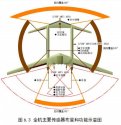Another chain link in the ASBM surveillance and tracking system. Unlike previous Sat this one is Geosynch and will provide persistent tracking
over wide area purportedly over 400 km square in one swoop
If this thing can keep track of large tanker than it should be able to track larger CBG with no problem
China launches HD earth observation satellite
by Staff Writers
Beijing (XNA) Dec 30, 2015
illustration only
China on Tuesday launched its most sophisticated observation satellite, Gaofen-4, as part of the country's high-definition (HD) earth observation project.
Gaofen-4 was launched from the Xichang Satellite Launch Center in the southwestern province of Sichuan at 00:04 a.m. aboard a Long March-3B carrier rocket. It was the 222th flight of the Long March rocket series, according to the State Administration of Science, Technology and Industry for National Defense (SASTIND).
Gaofen-4 is China's first geosynchronous orbit HD optical imaging satellite and the world's most sophisticated HD geosynchronous orbit remote sensing satellite, according to Xu Dazhe, head of SASTIND and China National Space Administration.
The successful launch of Gaofen-4 was the 19th space mission in this year. It will be used for disaster prevention and relief, surveillance of geological disasters and forest disasters, and meteorologic forecast, according to Tong Xudong, the chief designer of the Gaofen project with SASTIND.
The Gaofen project aims to launch seven high-definition observation satellites before 2020.
Gaofen-1, the first satellite of the project, was launched in April 2013.
Different from Gaofen-1 and Gaofen-2 in low orbits (600-700 km) around the earth, Gaofen-4 is located at the orbit 36,000 kilometers away from the earth and moves synchronously with the earth.
According to Li Guo, chief designer of Gaofen-4, this satellite can watch an oil tanker on the sea with its large CMOS camera, reaching the best imaging level among global high-orbit remote sensing satellites. It can view the entire area of Beijing and Tianjin at a glance. It will benefit countries and regions along the Belt and Road Initiative as well as providing services for various domestic industries.
Gaofen-4 is orbiting 36,000 kilometers away from the earth, much farther away than other remote sensing satellites which typically orbit at 500 km or at 1,000 km. High orbit satellite have the advantage of being able to snap "grand scenarios." Low orbit satellites, in contrast, can see more detail at faster speed.
Low orbit satellites cannot always follow natural disasters, but Gaofen-4 can continuously observe a disaster because it moves synchronously with the earth. It improves the response to disasters like earthquakes landslides and typhoons with its high-precision sensors.
Gaofen-4 has a designed lifespan of 8 years, compared to other remote sensing satellites which remain is service for less than 3 to 5 years.
Since the inception of the Gaofen project in 2013, China has an increasingly clearer view of the planet.
Gaofen-1, launched in April 2013, could cover the globe in merely 4 days. Gaofen-2, sent into space in August 2014, is able to resolve to 0.8 m in full color and collect multispectral images of objects of 3.2 meters or longer. The two satellites enable China to be basically self-sufficient in high-definition remote sensing data.
China will launch Gaofen-3 in 2016 and accelerate the research and development of Gaofen-6 and Gaofen-7. The goal of the Gaofen series is to provide all-weather, 24-hour service covering the globe.


